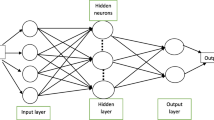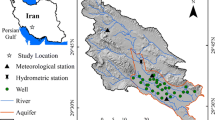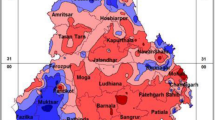Abstract
Irregular rainfall patterns and limited freshwater availability have driven humans to increase their dependence on groundwater resources. An essential aspect of effective water resources management is forecasting groundwater levels to ensure that sufficient quantities are available for future generations. Prediction models have been widely used to forecast groundwater levels at the regional scale. This study compares the accuracy of five commonly used data-driven models–Holt–Winters’ Exponential Smoothing, Seasonal Autoregressive Integrated Moving Average, Multi-Layer Perceptron, Extreme Learning Machine, and Neural Network Autoregression for simulating the declining groundwater levels of three monitoring wells in the National Capital Territory of Delhi in India. The performance of the selected models was compared using coefficient of determination (R2), Root Mean Squared Error (RMSE) and Mean Absolute Error (MAE). Results indicate that Multi-Layer Perceptron had high R2 while fitting the training data and least RMSE and MAE during testing, thus proving to be more accurate in forecasting than the other models. Multi-Layer Perceptron was used to forecast the groundwater level in the study wells for 2025. The results showed that the groundwater level will decline further if the current situation continues. Such studies help determine the appropriate model to be used for regions with limited available data. Additionally, predictions made for the future will help policymakers understand which areas need immediate attention in terms of groundwater management.





Similar content being viewed by others
Availability of Data and Material
The data used in this study have been obtained from the Central Ground Water Board, India and are available in the manuscript.
References
Aguilera H, Guardiola-Albert C, Naranjo-Fernández N, Kohfahl C (2019) Towards flexible groundwater-level prediction for adaptive water management: using Facebook’s Prophet forecasting approach. Hydrol Sci J 64(12):1504–1518. https://doi.org/10.1080/02626667.2019.1651933
Akaike H (1974) A New Look at the Statistical Model Identification. IEEE Trans Autom Control 19(6):716–723. https://doi.org/10.1109/TAC.1974.1100705
Aslam M, Lee JM, Hong S (2020) A multi-layer perceptron based deep learning model to quantify the energy potentials of a thin film a-Si PV system. Energy Rep 6:1331–1336. https://doi.org/10.1016/j.egyr.2020.11.025
Barzegar R, Asghari Moghaddam A, Adamowski J, Fijani E (2017) Comparison of machine learning models for predicting fluoride contamination in groundwater. Stochastic Environ Res Risk Assess 31(10):2705–2718. https://doi.org/10.1007/s00477-016-1338-z
Box GEP, Jenkins GM (1976) Series analysis forecasting and control. Prentice-Hall Inc., London
Brown RG (1959) Statistical forecasting for inventory control. McGraw-Hill, New York
Central Ground Water Board (2016) Aquifer map** and ground water management plan of NCT Delhi. New Delhi. http://cgwb.gov.in/AQM/AQM-Reports.html. Accessed 20 Oct 2021
Central Ground Water Board (2021) Groundwater Yearbook 2019-20. New Delhi. http://cgwb.gov.in/GW-Year-Book-State.html. Accessed 15 Nov 2021
Central Ground Water Board (2021b) Report: Dynamic ground water resources of NCT Delhi as on March 2020. New Delhi. http://cgwb.gov.in/Dynamic-GWResources.html. Accessed 20 Nov 2021
Chen C, He W, Zhou H, Xue Y, Zhu M (2020) A comparative study among machine learning and numerical models for simulating groundwater dynamics in the Heihe River Basin. Northwestern China Sci Rep 10:3904. https://doi.org/10.1038/s41598-020-60698-9
Choubin B, Malekian A (2017) Combined gamma and M-test-based ANN and ARIMA models for groundwater fluctuation forecasting in semiarid regions. Environ Earth Sci 76(15). https://doi.org/10.1007/s12665-017-6870-8
Crone SF, Kourentzes N (2010) Feature selection for time series prediction - A combined filter and wrapper approach for neural networks. Neurocomputing 73(10–12):1923–1936. https://doi.org/10.1016/j.neucom.2010.01.017
Faraway J, Chatfield C (1998) Time series forecasting with neural networks: A comparative study using the airline data. J R Stat Soc, C: Appl Stat 47(2):231–250. https://doi.org/10.1111/1467-9876.00109
Gao Y, Merz C, Lischeid G, Schneider M (2018) A review on missing hydrological data processing. Environ Earth Sci 77:47. https://doi.org/10.1007/s12665-018-7228-6
Hecht-Nielsen R (1989) Theory of the backpropagation neural network. In International 1989 Joint Conference on Neural Networks. Washington, DC, USA
Holt CC (1957) Forecasting trends and seasonals by exponentially weighted averages. In Carnegie Institute of Technology, Pittsburgh ONR memorandum no. 52
Huang GB, Zhu QY, Siew CK (2006) Extreme learning machine: theory and applications. Neurocomputing 70(1):489–501. https://doi.org/10.1016/j.neucom.2005.12.126
Hyndman RJ, Koehler AB, Ord JK, Snyder RD (2008) Forecasting with Exponential Smoothing: The State Space Approach. Springer
Hyndman R et al (2019) Forecast: forecasting functions for time series and linear models. R package version 8.7. http://pkg.robjhyndman.com/forecast. Accessed 15 Oct 2021
Hyndman RJ, Athanasopoulos G (2018) Forecasting: principles and practice. Melbourne, Australia: OTexts. https://otexts.org/fpp2/. Accessed 20 Oct 2021
Kalteh AM (2019) Modular wavelet-extreme learning machine: A new approach for forecasting daily rainfall. Water Resour Manag 33:3831–3849. https://doi.org/10.1007/s11269-019-02333-5
Kourentzes N, Barrow DK, Crone SF (2014) Neural network ensemble operators for time series forecasting. Expert Syst Appl 41(9):4235–4244. https://doi.org/10.1016/j.eswa.2013.12.011
Lallahem S, Mania J, Hani A, Najjar Y (2005) On the use of neural networks to evaluate groundwater levels in fractured media. J Hydrol 307(1–4):92–111. https://doi.org/10.1016/j.jhydrol.2004.10.005
Lee KJ, Carlin JB (2010) Multiple imputation for missing data: fully conditional specification versus multivariate normal imputation. Amer J Epidemiol 171:624–632
Lee S, Lee KK, Yoon H (2019) Using artificial neural network models for groundwater level forecasting and assessment of the relative impacts of influencing factors. Hydrogeol J 27(2):567–579. https://doi.org/10.1007/s10040-018-1866-3
Mirzavand M, Ghazavi R (2015) A stochastic modelling technique for groundwater level forecasting in an arid environment using time series methods. Water Resour Manag 29(4):1315–1328. https://doi.org/10.1007/s11269-014-0875-9
Mozaffari S, Javadi S, Moghaddam HK, Randhir TO (2022) Forecasting groundwater levels using a hybrid of support vector regression and particle swarm optimization. Water Resour Manag. https://doi.org/10.1007/s11269-022-03118-z
Narayanan P, Basistha A, Sarkar S, Kamna S (2013) Trend analysis and ARIMA modelling of pre-monsoon rainfall data for western India. C R Geosci 345(1):22–27. https://doi.org/10.1016/j.crte.2012.12.001
Natarajan N, Sudheer C (2020) Groundwater level forecasting using soft computing techniques. Neural Comput Appl 32:7691–7708. https://doi.org/10.1007/s00521-019-04234-5
Noori AR, Singh SK (2021) Spatial and temporal trend analysis of groundwater levels and regional groundwater drought assessment of Kabul. Afghanistan Environ Earth Sci 80:698. https://doi.org/10.1007/s12665-021-10005-0
Parisouj P, Mohebzadeh H, Lee T (2020) Employing machine learning algorithms for streamflow prediction: A case study of four river basins with different climatic zones in the United States. Water Resour Manag 34:4113–4131. https://doi.org/10.1007/s11269-020-02659-5
Poursaeid M, Poursaeid AH, Shabanlou SA (2022) A comparative study of artificial intelligence models and a statistical method for groundwater level prediction. Water Resour Manag 36:1499–1519. https://doi.org/10.1007/s11269-022-03070-y
Rahaman M, Thakur B, Kalra A, Ahmad S (2019) Modeling of GRACE-derived groundwater information in the colorado river basin. Hydrol 6(1):19. https://doi.org/10.3390/hydrology6010019
Sakizadeh M, Mohamed MMA, Klammler H (2019) Trend analysis and spatial prediction of groundwater levels using time series forecasting and a novel spatio-temporal method. Water Resour Manag 33(4):1425–1437. https://doi.org/10.1007/s11269-019-02208-9
Salvadore E, Bronders J, Batelaan O (2015) Hydrological modelling of urbanized catchments: A review and future directions. J Hydrol 529(1):62–81. https://doi.org/10.1016/j.jhydrol.2015.06.028
Sarma R, Singh SK (2021a) Temporal variation of groundwater levels by time series analysis for NCT of Delhi, India. In: Mehta YA, Carnacina I, Kumar DN, Rao KR, Kumari M (eds) Advances in Water Resources and Transportation Engineering. Lecture Notes in Civil Engineering (149). Springer, Singapore. https://doi.org/10.1007/978-981-16-1303-6_15
Sarma R, Singh SK (2021b) Simulating contaminant transport in unsaturated and saturated groundwater zones. Water Environ Res 93(9):1496–1509. https://doi.org/10.1002/wer.1555
Schwarz G (2007) Estimating the dimension of a model. Ann Stat 6(2):461–464. https://doi.org/10.1214/aos/1176344136
Shirmohammadi B, Vafakhah M, Moosavi V, Moghaddamnia A (2013) Application of several data-driven techniques for predicting groundwater level. Water Resour Manag 27(2):419–432. https://doi.org/10.1007/s11269-012-0194-y
Shumway RH, Stoffer DS (2016) Time series analysis and its applications With R Examples EZ Edition. Springer Texts in Statistics. Springer Series in Statistics, EZ Edition, New York
Singh A (2014) Groundwater resources management through the applications of simulation modeling: A review. Sci Total Environ 499:414–423. https://doi.org/10.1016/j.scitotenv.2014.05.048
Takafuji EHDM, Rocha MMD, Manzione RL (2019) Groundwater level prediction/forecasting and assessment of uncertainty using SGS and ARIMA models: A case study in the Bauru Aquifer System (Brazil). Nat Resour Res 28(2):487–503. https://doi.org/10.1007/s11053-018-9403-6
van Buuren S, Groothuis-Oudshoorn K (2011) MICE: Multivariate imputation by chained equations in R. J Stat Softw 45(3):1–67. https://www.jstatsoft.org/v45/i03/
Winters PR (1960) Forecasting sales by exponentially weighted moving averages. Manage Sci 6(3):324–342. https://doi.org/10.1287/mnsc.6.3.324
Yan Q, Ma C (2016) Application of integrated ARIMA and RBF network for groundwater level forecasting. Environ Earth Sci 75(5):1–13. https://doi.org/10.1007/s12665-015-5198-5
Yang Q, Wang Y, Zhang J, Delgado J (2017) A comparative study of shallow groundwater level simulation with three time series models in a coastal aquifer of South China. Appl Water Sci 7(2):689–698. https://doi.org/10.1007/s13201-015-0282-2
Yang ZP, Lu WX, Long YQ, Li P (2009) Application and comparison of two prediction models for groundwater levels: A case study in Western Jilin Province. China J Arid Environ 73(4–5):487–492. https://doi.org/10.1016/j.jaridenv.2008.11.008
Zhang Z, Zhang Q, Singh VP (2018) Univariate streamflow forecasting using commonly used data-driven models: literature review and case study. Hydrol Sci J 63(7):1091–1111. https://doi.org/10.1080/02626667.2018.1469756
Acknowledgements
The authors acknowledge the support of the Central Ground Water Board, India and thank the CGWB and India-WRIS for providing the data for this study. The authors also thank the Delhi Technological University, New Delhi for providing the facilities for this study.
Author information
Authors and Affiliations
Contributions
Conceptualization and methodology: RS, SKS; Analysis and investigation: RS; Supervision: SKS; Writing – original draft preparation: RS; Writing – review and editing: RS, SKS.
Corresponding author
Ethics declarations
Ethical approval
Not applicable.
Consent to Participate
Not applicable.
Consent to Publish
The authors hereby grant all rights of publication of the manuscript to the publisher.
Competing Interests
The authors have no relevant financial or non-financial interests to disclose.
Additional information
Publisher's Note
Springer Nature remains neutral with regard to jurisdictional claims in published maps and institutional affiliations.
Highlights
• A number of different data-driven models exist for forecasting groundwater levels.
• In the present study, Multi-Layer Perceptron was the most accurate model for groundwater level forecasting.
• Accuracy measures - coefficient of determination, Root Mean Squared Error and Mean Absolute Error were compared to determine the most precise model.
• Multi-Layer Perceptron forecasts for 2025 showed a decline of 2-21 mbgl in the study wells.
Supplementary Information
Below is the link to the electronic supplementary material.
Rights and permissions
About this article
Cite this article
Sarma, R., Singh, S.K. A Comparative Study of Data-driven Models for Groundwater Level Forecasting. Water Resour Manage 36, 2741–2756 (2022). https://doi.org/10.1007/s11269-022-03173-6
Received:
Accepted:
Published:
Issue Date:
DOI: https://doi.org/10.1007/s11269-022-03173-6




